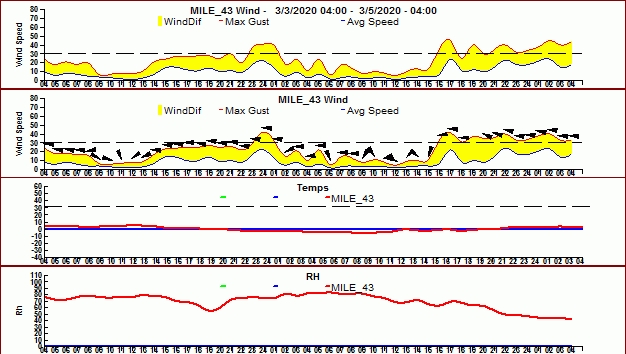Heading out today to enjoy some sunshine? The outflow winds are forecast to continue through the day. Paying attention to what the wind is doing and has done in the terrain you are traveling will be crucial. Observing the outflow winds (west/northwest) in the forecast area yesterday was pretty interesting and as often the case with this wind pattern, the impact was not straightforward. Pluming was observed in the mountains around Girdwood but there was not much wind at Alyeska. Winds were channeled through the Arm and into Placer Valley but wind speeds were light at the Seattle Ridge weather station. Sunburst weather station reported mostly light northwest winds but observers on Sunburst felt the wind coming through the Pass from the south. Looking at the south end of Seattle Ridge, near the Johnson Pass north trail head, the pluming was obvious. A natural wind slab was observed in motion near the Hope Y mid-day. From there south to Lost Lake the wind transport was notable. As Wendy mentioned yesterday many of our ridgetop weather stations don’t pick up the northwest flow direction very well. AKRR MP 43 weather station that sits near Bench Peak, above and to the west of Grandview, does seem to capture these winds. Steady winds in the 20s with gusts into the 40s were recorded in the late afternoon and overnight.
Wind Slabs: Other than witnessing active wind loading and slabs developing while you are on slope, pay attention to surface conditions indicating previous wind loading. Be on the lookout for stiff snow over softer snow, shooting cracks and drifting patterns near ridgelines and in gullies. Also keep in mind that a layer of buried surface hoar may be sitting under wind slabs, making them easier to trigger and possibly propagate further above or to the side than expected.

Wind on peak 4,940 (South end of Seattle Ridge across from Johnson Pass north TH ) at 4:30pm. 3.4.20. Photo: Nick D’Alessio

AKRR MP 43 weather station data.
Cornices: Small fresh cornice falls from winds today are possible in areas seeing significant wind. Most likely outside of the forecast zone.
Loose snow avalanches: In areas out of the wind, sluffs are possible in steep terrain.
Sun effect: The wind and cold temperatures should overrule any sun effect today.


